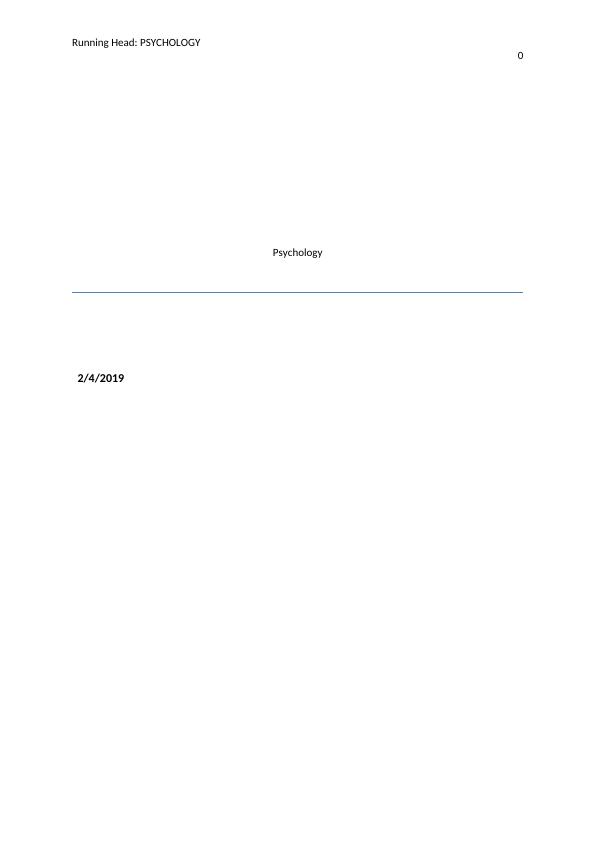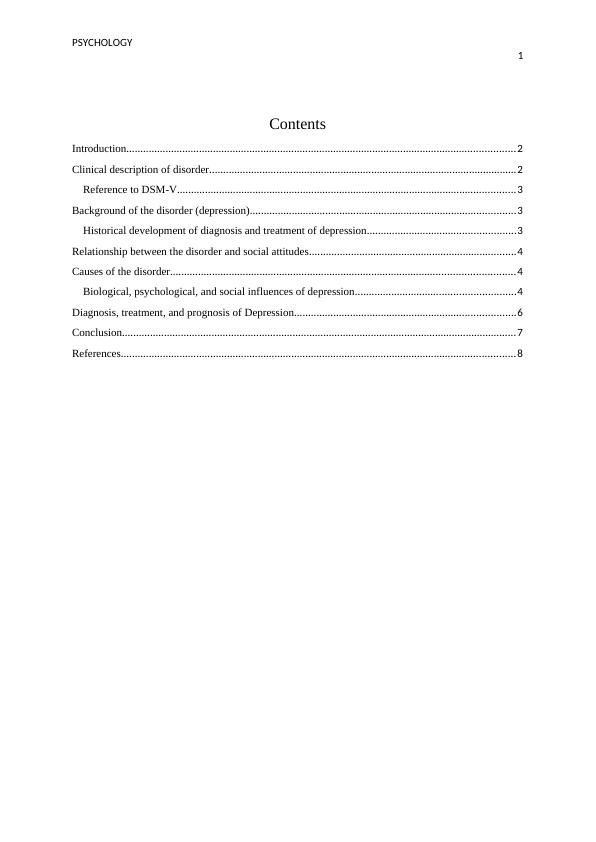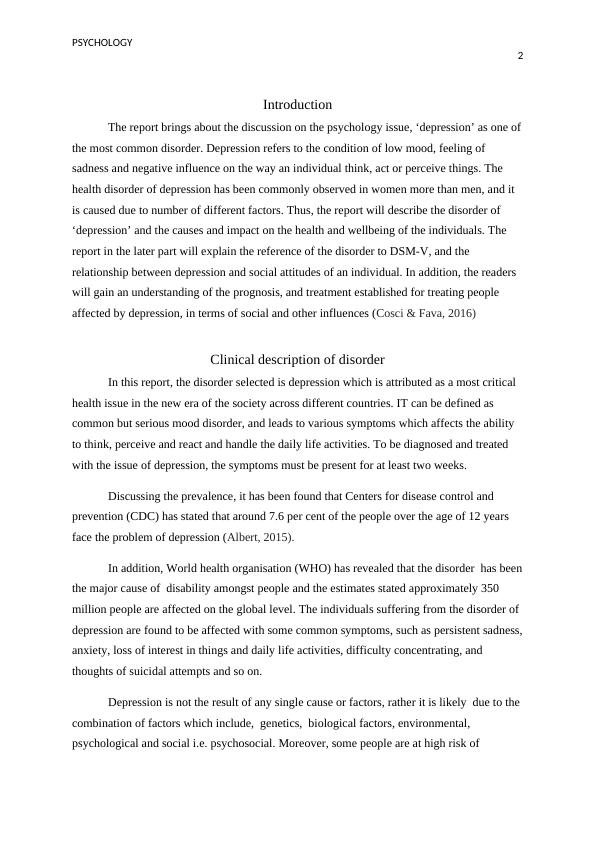Psychology, Biological and social influences of depression
Added on 2023-04-26
11 Pages3309 Words287 Views
Running Head: PSYCHOLOGY
0
Psychology
2/4/2019
0
Psychology
2/4/2019

PSYCHOLOGY
1
Contents
Introduction...........................................................................................................................................2
Clinical description of disorder..............................................................................................................2
Reference to DSM-V.........................................................................................................................3
Background of the disorder (depression)...............................................................................................3
Historical development of diagnosis and treatment of depression.....................................................3
Relationship between the disorder and social attitudes..........................................................................4
Causes of the disorder...........................................................................................................................4
Biological, psychological, and social influences of depression.........................................................4
Diagnosis, treatment, and prognosis of Depression...............................................................................6
Conclusion.............................................................................................................................................7
References.............................................................................................................................................8
1
Contents
Introduction...........................................................................................................................................2
Clinical description of disorder..............................................................................................................2
Reference to DSM-V.........................................................................................................................3
Background of the disorder (depression)...............................................................................................3
Historical development of diagnosis and treatment of depression.....................................................3
Relationship between the disorder and social attitudes..........................................................................4
Causes of the disorder...........................................................................................................................4
Biological, psychological, and social influences of depression.........................................................4
Diagnosis, treatment, and prognosis of Depression...............................................................................6
Conclusion.............................................................................................................................................7
References.............................................................................................................................................8

PSYCHOLOGY
2
Introduction
The report brings about the discussion on the psychology issue, ‘depression’ as one of
the most common disorder. Depression refers to the condition of low mood, feeling of
sadness and negative influence on the way an individual think, act or perceive things. The
health disorder of depression has been commonly observed in women more than men, and it
is caused due to number of different factors. Thus, the report will describe the disorder of
‘depression’ and the causes and impact on the health and wellbeing of the individuals. The
report in the later part will explain the reference of the disorder to DSM-V, and the
relationship between depression and social attitudes of an individual. In addition, the readers
will gain an understanding of the prognosis, and treatment established for treating people
affected by depression, in terms of social and other influences (Cosci & Fava, 2016)
Clinical description of disorder
In this report, the disorder selected is depression which is attributed as a most critical
health issue in the new era of the society across different countries. IT can be defined as
common but serious mood disorder, and leads to various symptoms which affects the ability
to think, perceive and react and handle the daily life activities. To be diagnosed and treated
with the issue of depression, the symptoms must be present for at least two weeks.
Discussing the prevalence, it has been found that Centers for disease control and
prevention (CDC) has stated that around 7.6 per cent of the people over the age of 12 years
face the problem of depression (Albert, 2015).
In addition, World health organisation (WHO) has revealed that the disorder has been
the major cause of disability amongst people and the estimates stated approximately 350
million people are affected on the global level. The individuals suffering from the disorder of
depression are found to be affected with some common symptoms, such as persistent sadness,
anxiety, loss of interest in things and daily life activities, difficulty concentrating, and
thoughts of suicidal attempts and so on.
Depression is not the result of any single cause or factors, rather it is likely due to the
combination of factors which include, genetics, biological factors, environmental,
psychological and social i.e. psychosocial. Moreover, some people are at high risk of
2
Introduction
The report brings about the discussion on the psychology issue, ‘depression’ as one of
the most common disorder. Depression refers to the condition of low mood, feeling of
sadness and negative influence on the way an individual think, act or perceive things. The
health disorder of depression has been commonly observed in women more than men, and it
is caused due to number of different factors. Thus, the report will describe the disorder of
‘depression’ and the causes and impact on the health and wellbeing of the individuals. The
report in the later part will explain the reference of the disorder to DSM-V, and the
relationship between depression and social attitudes of an individual. In addition, the readers
will gain an understanding of the prognosis, and treatment established for treating people
affected by depression, in terms of social and other influences (Cosci & Fava, 2016)
Clinical description of disorder
In this report, the disorder selected is depression which is attributed as a most critical
health issue in the new era of the society across different countries. IT can be defined as
common but serious mood disorder, and leads to various symptoms which affects the ability
to think, perceive and react and handle the daily life activities. To be diagnosed and treated
with the issue of depression, the symptoms must be present for at least two weeks.
Discussing the prevalence, it has been found that Centers for disease control and
prevention (CDC) has stated that around 7.6 per cent of the people over the age of 12 years
face the problem of depression (Albert, 2015).
In addition, World health organisation (WHO) has revealed that the disorder has been
the major cause of disability amongst people and the estimates stated approximately 350
million people are affected on the global level. The individuals suffering from the disorder of
depression are found to be affected with some common symptoms, such as persistent sadness,
anxiety, loss of interest in things and daily life activities, difficulty concentrating, and
thoughts of suicidal attempts and so on.
Depression is not the result of any single cause or factors, rather it is likely due to the
combination of factors which include, genetics, biological factors, environmental,
psychological and social i.e. psychosocial. Moreover, some people are at high risk of

PSYCHOLOGY
3
depression due to some other issues such as childhood trauma, abuse of recreational drugs,
personality, and several others (Park et al., 2018).
Reference to DSM-V
The Diagnostic and Statistical Manual for Mental Disorders (DSM-V) refers to the
2013 update in the field of psychiatric nomenclature named as DSM-5. The tool has been
published by the American Psychiatric Association (APA), and has been identified as the
principal authority for psychiatric diagnoses.
Discussing the reference of depression to DSM-V, it has been observed that it outlines
the criterion for the diagnosis of depression. The criteria states that the individual must be
experiencing the symptoms, i.e. five or more within the period of two-weeks. Moreover, there
should be the symptoms, which could be either depressive mood or the loss of interest in
things. Further, the diagnosis must lead to the clinically important distress to the individual or
having any issue in the social, occupational, or any other aspect of functioning (Woolf et al.,
2016).
Background of the disorder (depression)
Historical development of diagnosis and treatment of depression
Discussing about the historical development of the depression and treatment during
the late 19th and 20th century, it has been found that depression was earlier called as
‘melancholia’. Moreover, the treatment for severe depression was not enough to help patient
and the other affected people (Acharya et al., 2015).
First historical understanding of depression was considered as mental or spiritual
illness, rather than a physical one. Many people were given relief with the help of
lobotomies, which were the surgeries developed to destroy the frontal part of the brain. In
actual sense, these were used by the clinicians due to the reason that they have a calming
effect. Electroconvulsive was one therapy, is an electric shock which was applied to the scalp
in order to induce seizure, has been used many of the times for treating depression. During
the earlier years, the disorder has been classified or divided into many categories by the
doctors, as ‘endogenous’ , ‘reactive’, or ‘neurotic’ depression (Portaccio, 2016).
3
depression due to some other issues such as childhood trauma, abuse of recreational drugs,
personality, and several others (Park et al., 2018).
Reference to DSM-V
The Diagnostic and Statistical Manual for Mental Disorders (DSM-V) refers to the
2013 update in the field of psychiatric nomenclature named as DSM-5. The tool has been
published by the American Psychiatric Association (APA), and has been identified as the
principal authority for psychiatric diagnoses.
Discussing the reference of depression to DSM-V, it has been observed that it outlines
the criterion for the diagnosis of depression. The criteria states that the individual must be
experiencing the symptoms, i.e. five or more within the period of two-weeks. Moreover, there
should be the symptoms, which could be either depressive mood or the loss of interest in
things. Further, the diagnosis must lead to the clinically important distress to the individual or
having any issue in the social, occupational, or any other aspect of functioning (Woolf et al.,
2016).
Background of the disorder (depression)
Historical development of diagnosis and treatment of depression
Discussing about the historical development of the depression and treatment during
the late 19th and 20th century, it has been found that depression was earlier called as
‘melancholia’. Moreover, the treatment for severe depression was not enough to help patient
and the other affected people (Acharya et al., 2015).
First historical understanding of depression was considered as mental or spiritual
illness, rather than a physical one. Many people were given relief with the help of
lobotomies, which were the surgeries developed to destroy the frontal part of the brain. In
actual sense, these were used by the clinicians due to the reason that they have a calming
effect. Electroconvulsive was one therapy, is an electric shock which was applied to the scalp
in order to induce seizure, has been used many of the times for treating depression. During
the earlier years, the disorder has been classified or divided into many categories by the
doctors, as ‘endogenous’ , ‘reactive’, or ‘neurotic’ depression (Portaccio, 2016).

End of preview
Want to access all the pages? Upload your documents or become a member.
Related Documents
Psychiatric Diagnostic Classification Systems and Suboptimal Outcome for Patientslg...
|7
|2180
|425
Understanding Depression: Clinical Manifestation and Psychopathologylg...
|12
|3430
|498
Borderline Personality Disorder | PPTlg...
|2
|870
|21
Psychological Disorders and Treatmentlg...
|8
|1420
|193
Psychopathological Condition Essaylg...
|10
|2631
|36
Psychological Disorder Research Paper- Schizophrenialg...
|15
|4041
|73
